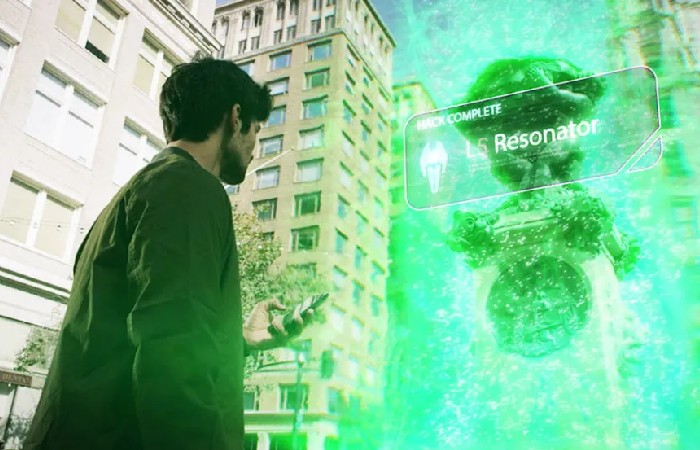Alternate Reality Games, or ARGs, have overtaken the entertainment world. For those unfamiliar with the concept, an ARG is an interactive game where players become part of a larger story that unfolds across multiple platforms and mediums.
With its complex puzzles, immersive narratives, and collaborative gameplay, ARGs offer a unique and compelling gaming experience that goes far beyond the traditional boundaries of online video games like Overwatch.
ARGs have been used to promote movies, T.V. shows, and even political campaigns, but they’re also popular with gamers and puzzle enthusiasts looking for a new and challenging experience.
These games are available for online play, on mobile devices, or in real-life settings, catering to individuals with an internet connection and a spirit of adventure. This accessibility extends to Battle Royale-style games such as Fortnite, excluding the incorporation of virtual reality.
Characteristics of ARGs

ARGs have distinct features that set them apart from other games, including a collaborative and immersive experience, a transmedia narrative that evolves across multiple platforms, and the use of real-life locations and clues to solve the game.
ARGs are games that combine elements of narrative, reality, and gameplay to create an immersive experience.
Some of the standard features of ARG games include:
Transmedia storytelling
ARG games usually feature a story that unfolds across different platforms and media, such as text messages, websites, social media, emails, phone calls, etc. It allows players to immerse themselves in the game world and discover clues and details that intertwine across multiple platforms.
Real-Time Interaction
ARG games are often developed in real-time, meaning they evolve and progress even when players aren’t actively playing. Players must be vigilant and engage in the game at specific times to avoid missing out on important events and opportunities.
Collaboration between players
ARG games encourage collaboration between players, as challenges often present themselves that require multiple people to work together to solve. It can include sharing information, forming teams, and communicating to crack codes, solve puzzles, and overcome obstacles.
Fiction and reality combined
ARGs break down the boundaries between fantasy and reality, creating situations where players must interact with fictional characters and elements in the context of the real world. It can include incorporating real locations, events, or people into the game’s plot.
Discovery & Exploration
ARG games often require players to search for and discover clues, hidden objects, and hidden details in the natural and virtual world. It may involve researching websites, visiting physical locations, cracking codes, and following instructions to advance the game’s story.
Solving puzzles and challenges
ARG games typically present players with a series of puzzles and challenges they must solve to progress through the story. Finding solutions and uncovering additional clues may require critical thinking skills, creativity, and teamwork.
In addition, ARGs often involve a high level of engagement and participation from players, who can act as characters in the game or interact with other players on online forums and social media.
The game’s narrative often evolves in real-time, responding to players’ actions and decisions, creating a unique and unforgettable experience. As a result, ARGs have gained popularity among gamers, storytellers, and marketers alike, who appreciate the creativity and innovation involved in this unique gaming experience.
Benefits and Applications of ARGs
Alternate reality games (ARG) are interactive storytelling forms that have become increasingly popular in recent years. One of the main benefits of ARGs is that they provide a unique and engaging experience for participants.
ARGs encourage players to collaborate and solve puzzles, often building a sense of community and camaraderie among participants. ARGs can be used for various applications, including marketing campaigns, educational programs, and social activism.
Entertainment
ARG games offer a unique, immersive gaming experience combining fundamental and digital elements. Players can immerse themselves in an exciting storyline, solve puzzles and challenges, and collaborate with other players, providing an enriching entertainment experience.
Education
ARG games also have educational applications, as they can be used as teaching and learning tools. They can provide an interactive, hands-on approach to learning about different topics, such as history, science, math, problem-solving, and critical thinking skills.
Marketing & Advertising
ARG games have been used effectively in marketing and advertising campaigns. They allow brands and businesses to engage consumers uniquely, providing them with a fun and personalized experience related to their products or services.
Product & Event Promotion
ARG games also promote specific products and events. They can generate interest and create consumer expectations, attract new audiences, and generate excitement around an upcoming launch or event.
Skill Development
ARG games can help develop and improve various skills, such as teamwork, problem-solving, communication, decision-making, and creativity. Players often must collaborate and think critically to overcome the game’s challenges, strengthening these skills.
Exploration & Discovery
ARG games can encourage exploration and discovery in the natural and virtual worlds. They can take players to new locations, discover hidden details, and learn about different aspects and cultures.
Its applications are becoming increasingly diverse, and new ways to harness its potential in different fields are constantly being developed.
For example, an ARG could promote a new product by creating a story that engages players and encourages them to interact with the brand. Alternatively, an ARG could teach students about a particular topic or topic, creating an account that takes them on a journey of discovery.
ARGs can also raise awareness of social issues by creating a story encouraging players to take action and make a difference in the world. Overall, the benefits and applications of ARGs are wide and varied, making them an exciting and dynamic form of entertainment and engagement.
Examples of different applications of ARGs
Alternate reality games (ARGs) are immersive, interactive experiences that blur the boundaries between fact and fiction. They have gained popularity recently due to their ability to engage and captivate audiences, often for long periods.
One of the most intriguing aspects of ARGs is their wide range of applications. ARGs have been used for marketing and advertising campaigns, educational purposes, social awareness campaigns, and entertainment.
Marketing

Marketing plays a crucial role in the success of any alternate reality game (ARG). At its core, an ARG is a marketing tactic that aims to engage and captivate audiences by weaving complex and immersive stories across various media channels.
As such, it is essential to have a strategic and well-planned marketing approach. To ensure that the game reaches its target audience and generates the desired level of engagement. Effective ARG marketing involves identifying the target audience, developing an engaging story, creating buzz and a sense of anticipation around the game, leveraging social media platforms, and collaborating with influencers to expand the game’s reach.
By implementing these strategies, marketers can improve the gaming experience, drive engagement, and ultimately increase brand awareness and loyalty.
Some examples of the use of ARG games in marketing and some aspects to keep in mind to make sure it goes well are:
‘The Dark Knight: Why So Serious?’
In 2007, Warner Bros. used an ARG game to promote the movie ‘The Dark Knight.’ The ARG game involved users in a story where they had to solve clues and puzzles to find clues about the location of one of the characters in the movie. This generated great excitement and engagement from Batman fans, who felt involved in the game’s world and became more eager to see the film.
Things to keep in mind:
Brand Integration: The ARG game must align with the brand’s theme and values to ensure a consistent experience.
Clarity & Communication: There should be clear communication about the game’s rules, important dates, and instructions so that participants can understand and participate properly.
Diversity of challenges: The challenges should be varied and suitable for different types of players so that everyone can participate and enjoy the game.
Feedback & Rewards: It’s essential to provide feedback to players and offer tangible rewards or incentives to keep them interested and motivated in the game.
‘The Beast’:
In 2001, Microsoft and DreamWorks used an ARG game called ‘The Beast’ to promote the movie ‘A.I.: Artificial Intelligence’. The ARG game involved users in a complex and exciting story, where they had to solve puzzles and decipher hidden messages on various websites and other media.
Things to keep in mind:
Planning and coordination: Thorough planning and coordination are necessary to ensure all aspects of the game are in place and running smoothly.
Scalability: The ARG game must be scalable to allow many players to participate simultaneously.
Community & Participation: Fostering an active community around the ARG game can be very beneficial. This can include creating online forums and groups where players can discuss and share hints and ideas.
Time & Duration: Setting an appropriate duration for the ARG game is essential, avoiding it being too short or too long to keep the participants interested throughout the process.
Every ARG marketing and gaming campaign will be unique, so it’s essential to tailor these aspects to each campaign’s specific needs and goals.
Education

Education is essential to understanding and participating in alternate reality games (ARG). ARGs are complex games that often involve intricate puzzles and clues, requiring a certain level of knowledge and problem-solving skills.
A primary education in critical thinking, logic, and puzzle solving can be incredibly beneficial for those interested in participating in ARGs. In addition, knowledge of different subjects such as history, literature, and science can be helpful in deciphering clues and solving puzzles.
Additionally, understanding technology and digital media is becoming increasingly important in today’s digital landscape, as many ARGs are played online and rely on technology to solve puzzles.
ARG (Alternate Reality Games) technology can benefit education by providing an immersive and participatory learning experience. Several ways in which ARG technology can be leveraged in education are:
Active and hands-on learning
ARG games engage students in a dynamic and hands-on way in the learning process. The challenges and puzzles presented in the game require the application of knowledge and skills in real-world situations, which helps students better understand and retain information.
Motivation and engagement
ARG games keep players engaged and motivated. The same dynamic can be harnessed in education, where ARG games can make learning more exciting for students, increasing their motivation and engagement with course content.
Skill development
ARG games encourage the development of various skills, such as problem-solving, decision-making, communication, and collaboration. By integrating ARG games into the curriculum, students can develop and strengthen these critical skills essential to their success in education and the world of work.
Collaborative Learning
ARG games also encourage collaboration and teamwork, as they often involve the need for students to work together to solve challenges and advance the game’s plot. It promotes the construction of soft skills and improves students’ ability to collaborate effectively in educational and professional settings.
Immediate feedback
ARG games can provide immediate feedback to students as they progress through the game. It allows students to quickly understand if they have made the right decision or need to adjust their strategy. This real-time feedback helps students identify areas for improvement and learn from their mistakes more effectively.
Integration of multiple disciplines
ARG games can address various fields in a single game, allowing students to see the connections between different areas of knowledge. It facilitates interdisciplinary learning and helps students understand how concepts apply in the real world.
To get the most out of ARG technology in the field of education, it’s essential to keep a few considerations in mind:
Define clear learning objectives: Identify the specific learning objectives you want to achieve when using ARG games in the classroom. It will help design the game effectively and ensure it aligns with the desired learning outcomes.
Integration with the curriculum: ARG games should be closely connected to the existing curriculum and the taught topics. It will ensure that the match aligns with educational goals and allows students to apply and reinforce concepts learned in the classroom.
Monitoring and Evaluation: Monitoring and evaluating student progress and learning during ARG play is essential. It can be done through formative assessments, direct observation, and group discussions. The feedback provided during and after the game will help adapt and improve future implementations.
Accessibility & Equity: It is essential to ensure that ARG games are accessible to all students, regardless of skill level or disability. It may involve adapting the game to make it more inclusive or providing additional support to those who need it.
ARG technology offers a unique opportunity to transform the way students learn by providing an immersive and engaging experience. By leveraging this technology in education, more interactive, hands-on, and collaborative learning can be achieved, better preparing students to meet real-world challenges.
Entertainment

ARG (Alternate Reality Games) technology can be leveraged in various ways in entertainment to create more immersive and engaging experiences.
Here are some ways to use ARG technology in entertainment:
Creating Immersive Stories
ARG games allow players to immerse themselves in an interactive story that blends into the real world. Using real-world elements such as websites, phone calls, in-person events, etc., a compelling and exciting narrative can be created that engages players in the plot and makes them feel like protagonists of the story.
Challenges and Puzzles
ARG games can include challenges and riddles players must solve to progress through the story. These challenges can be both online and in the real world, which adds an extra dimension to the entertainment and challenges players’ intelligence and problem-solving skills.
Community Involvement
ARG games are inherently social, encourage collaboration among players, and can attract a community of passionate followers. Players can interact online and offline, share hints and strategies, and develop social relationships while participating in the game experience.
Multi-platform integration
ARG games benefit from using multiple platforms, such as social media, mobile apps, websites, and in-person events. This platform integration allows for greater interactivity and offers players a more immersive and diverse experience.
Collaboration with brands
ARG games can collaborate with brands or products to promote them innovatively and experientially. Incorporating branded elements into the game’s story and challenges creates a unique and memorable experience for players, leading to excitement and engagement with the brand.
Live Events
ARG games can also take advantage of live events to provide players with an even more exciting experience. These events can include in-game scenarios, live actors, hidden clues, and interactive role-playing. Combining live elements with ARG games creates an authentic and immersive experience for participants.
ARG technology offers many exciting opportunities in the field of entertainment by providing an interactive and immersive experience that crosses the boundaries between the real and digital worlds.
By leveraging this technology, it is possible to create exciting stories, engaging challenges, and social experiences for players, offering a unique form of entertainment beyond traditional media.
What is ARG’s relationship with augmented reality games?
The relationship between ARG (Alternate Reality Games) and augmented reality (ARR) games can be very close, as both concepts share certain similarities and complement each other in many ways.
ARG is based on creating an interactive narrative combining real-world and digital elements to provide players with a unique and immersive experience. On the other hand, augmented reality games leverage technology to overlay virtual elements on the natural world through a device, such as a smartphone or augmented reality glasses. It allows players to interact with digital objects and characters in their physical environment.
The main difference between ARG and augmented reality games is how the experience is accessed and interacted. In ARG, players usually access it through online platforms, such as websites, mobile apps, or social media, where the game’s story and challenges are presented. These challenges may require players to search for clues in the real world, but the primary interaction is usually digital.
On the other hand, augmented reality games are experienced directly in the physical world using virtual object overlay technology. Players can physically see, interact, and move around their environment to engage in the game experience.
Despite their differences, the two technologies can be effectively combined into a hybrid game that leverages ARG’s narrative, interactive elements, and augmented reality aspects.
Example
An ARG game designed to take advantage of augmented reality may require players to search for clues and solve puzzles in their physical environment using an augmented reality device. It creates an even more immersive experience and combines real-world and digital elements to power the game.
The relationship between ARG and augmented reality games is that they both seek to provide interactive and immersive experiences by combining elements of the natural world and the digital world. While each concept has distinctive features, they can complement each other to create unique and engaging entertainment or learning experiences.
Famous Examples of Augmented Reality Games

Augmented reality (ARG) games have become increasingly popular in recent years, captivating players with immersive and interactive gameplay.
Here are some famous examples of augmented reality games and briefly explain each one:
Pokémon Go
Launched in 2016, Pokémon Go became a worldwide phenomenon by combining the popular Pokémon franchise with augmented reality technology. Players can use their mobile devices to search for and catch Pokémon in real-world environments. A.R. technology allows Pokémon to appear overlaid on the phone’s camera, allowing players to experience encountering Pokémon in their settings.
Ingress
Developed by Niantic, the same team behind Pokemon Go, Ingress is an augmented reality game based on capturing virtual areas in the real world. Players join one of two factions and work together to capture and control ‘portals’ in real locations, such as historical monuments or tourist sites. Players can interact with these portals to unlock the game’s story through their mobile camera.
Harry Potter Wizards Unite:
Also developed by Niantic, this augmented reality game allows players to immerse themselves in the magical world of Harry Potter. Players participate as wizards and witches of the wizarding world and must explore the natural world in search of magical artifacts and creatures. Augmented reality overlays these creatures and artifacts onto the player’s environment, providing an immersive gaming experience.
Minecraft Earth
Based on the popular building game Minecraft, Minecraft Earth uses augmented reality to allow players to create and explore virtual structures in the real world. Players can roam their surroundings with a mobile device and build virtual systems in real-world locations using overlay technology. Other players can also watch and collaborate on the build, encouraging social interaction and creativity.
Jurassic World Alive
This augmented reality game allows players to capture, breed, and fight dinosaurs in the real world. Players can search for and find dinosaurs superimposed on their physical environment using their device’s camera. They can also collect DNA from different species of dinosaurs to create their hybrid creatures.
These examples use A.R. technology to add virtual elements to the real world and provide players with interactive, immersive experiences. Each game offers unique features and different ways to interact with augmented reality. Still, they all share the basic premise of combining digital and physical elements to create an immersive gaming experience.
Alternate reality games (ARGs) offer a unique and exciting way to engage in storytelling and interactive experiences.
ARGs are incredibly versatile, finding applications in entertainment, marketing, education, and even social and political activism. Their capacity to blur fact and fiction creates immersive, unforgettable experiences for players. As ARGs evolve, they remain a compelling and potent means of engaging audiences innovatively.
Review:
ARGs offer a unique form of entertainment, bridging the gap between storytelling, reality, and gameplay. Their immersive and collaborative nature, transmedia storytelling, and integration of real-life elements make them a compelling choice for those seeking a gaming experience that goes beyond traditional video games.





